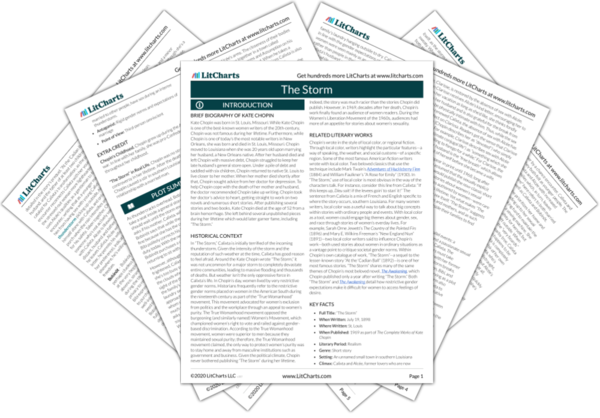“The Storm” complicates the traditional symbolic significance of the color white—a common symbol for purity—by making it also represent sexual passion. First, Chopin describes the sensual areas of Calixta’s body—namely her throat and her breasts—as white, conflating the color with bodily pleasure. Second, Chopin uses white to describe Calixta and Bobinôt’s bedroom, where Alcée and Calixta have sex. Third, Chopin describes Calixta’s sexual desire for Alcée as a “white flame.” Through each mention of white, Chopin engages color traditionally associated with sexual innocence to describe the occurrence of sex itself—and extramarital sex, at that.
Chopin also describes lightening striking a tree with a reference to pale colors, noting that “[i]t filled all visible space with a blinding glare.” In doing so, Chopin develops the symbol of Calixta’s sexual desire, the thunderstorm, through associations to purity. As most readers will automatically associate white with virtue, Chopin implicitly associates Alcée and Calixta’s affair—steeped in white—with virtue, too. Thus, rather than cast sex between Alcée and Calixta as sinful transgression, the brief affair is described as a blameless, beautiful act of pure love.
The Color White Quotes in The Storm
Calixta, at home, felt no uneasiness for their safety. She sat at a side window sewing furiously on a sewing machine. She was greatly occupied and did not notice the approaching storm. But she felt very warm and often stopped to mop her face, on which the perspiration gathered in beads. She unfastened her white sacque at the throat.

Unlock explanations and citation info for this and every other The Storm quote.
Plus so much more...
Get LitCharts A+He pushed her hair back from her face that was warm and steaming. Her lips were as red and moist as pomegranate seed. Her white neck and a glimpse of her full, firm bosom disturbed him powerfully. As she glanced up at him the fear in her liquid blue eyes had given place to a drowsy gleam that unconsciously betrayed a sensuous desire.












